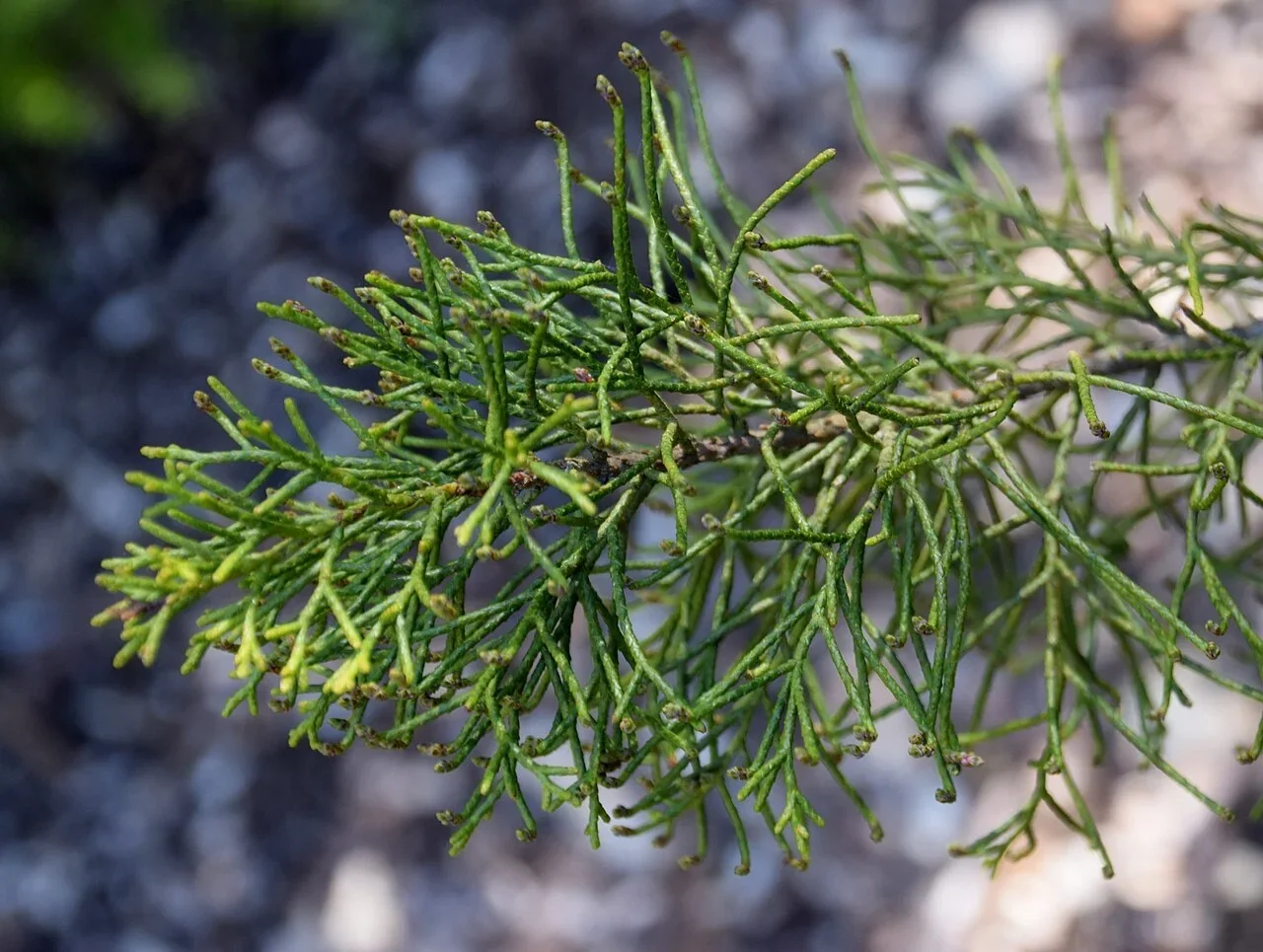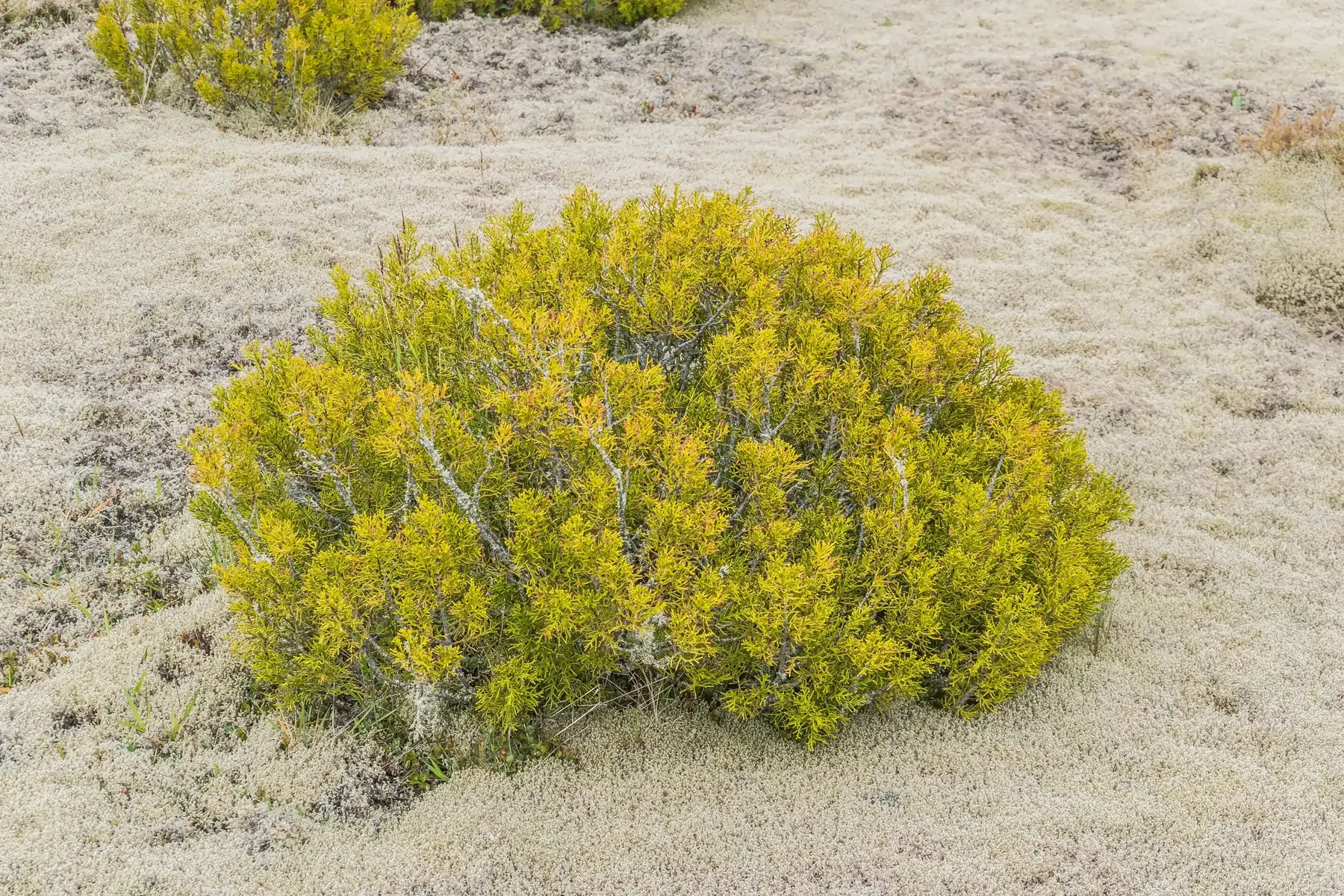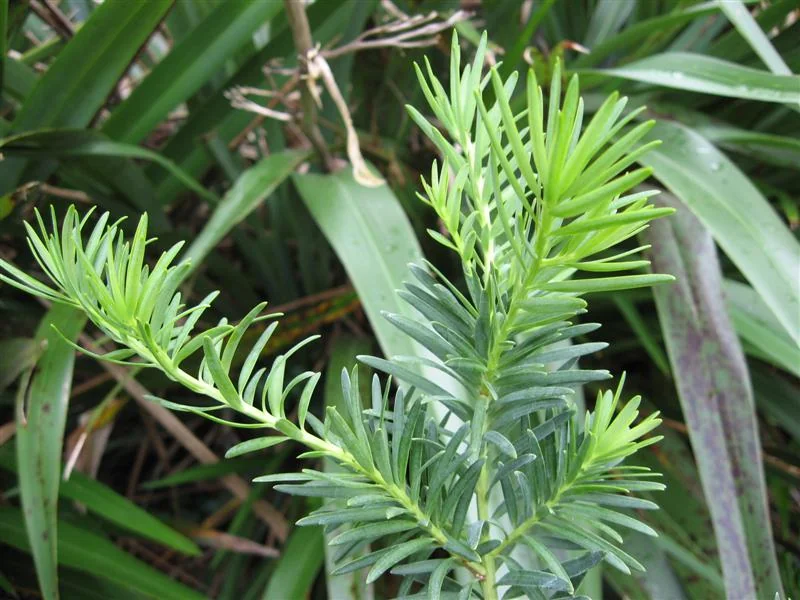
Yellow Pine
Halocarpus biformis
Yellow Pine ( Halocarpus biformis ) is a distinctive native New Zealand conifer among New Zealand's native trees , known for its variable growth habit, ranging from a sprawling shrub in exposed alpine areas to an erect tree in more sheltered forest environments. Its foliage is characterized by small, scale-like leaves that are often bronze-tinged, especially in colder conditions. This hardy species is found in a wide range of habitats across New Zealand, from lowland forests to subalpine scrub. Yellow Pine is a slow-growing, long-lived plant that adds unique texture and character to native plant gardens, rockeries, or as a specimen tree, showcasing the ancient lineage of New Zealand's conifers.

Plant Description
Botanical Features
Halocarpus biformis , commonly known as Yellow Pine, Pink Pine, or Alpine Tarwood, is an evergreen conifer endemic to New Zealand. The name "biformis" (Latin for "two forms") refers to the distinct difference between its juvenile and adult foliage. It can grow as a tree up to 10 meters tall with a short, crooked trunk, or as a shrub in exposed, often alpine, locations, sometimes not exceeding 1 meter. The bark is thin, smooth, and reddish-brown when young, weathering to gray and flaking off in small, thick scales. It exhibits dimorphic foliage: juvenile leaves are linear, 10-20 mm long and 1.5-3 mm wide, while adult leaves are scale-like, yellowish-green to dark green, 1-2 mm long, densely overlapping, and strongly keeled. It is a dioecious species, with male and female cones on separate plants. The wood is pinkish-coloured, dense, fine-grained, sweetly perfumed, and extremely durable. It is found in montane to subalpine scrubland, scrub, and forest, from the central North Island down to sea level in southern parts of the South Island.
Quick Facts
Conifer Summary
| Scientific Name | Halocarpus Biformis |
|---|---|
| Common Name | Yellow Pine, Monoao |
| Family | Podocarpaceae |
| Height | Up to 10 m (tree form), 0.5-2 m (shrub form) |
| Spread | Up to 3 m |
| Light | Full sun to partial shade |
| Soil | Well-drained, acidic soils |
| Water Needs | Moderate |
| Frost Tolerance | High |
| Salt Tolerance | Low to Moderate |
| Growth Rate | Slow |
| Lifespan | Long |
Climate Best Suited to
Yellow Pine ( Halocarpus biformis ) is widely distributed across New Zealand, from lowland to subalpine and alpine zones, indicating its broad adaptability to various climates. It thrives in cool, moist temperate climates but is remarkably tolerant of a wide range of conditions, including strong winds, cold temperatures, and moderate frosts. Its natural habitat includes boggy areas, forest margins, and open scrublands. It can be successfully cultivated in most temperate regions, provided it has good drainage and protection from extreme, prolonged droughts or severe, sustained frosts when young.
Regional Suitability
| City | Climate Suitability |
|---|---|
| Whangārei | Ideal |
| Auckland | Ideal |
| Hamilton | Ideal |
| Tauranga | Ideal |
| Rotorua | Ideal |
| Gisborne | Ideal |
| New Plymouth | Ideal |
| Napier | Ideal |
| Whanganui | Ideal |
| Palmerston North | Ideal |
| Wellington | Ideal |
| Nelson | Ideal |
| Christchurch | Ideal |
| Dunedin | Ideal |
| Invercargill | Ideal |
Natural Habitat
Typical Environments
Understand the natural habitat of Yellow Pine ( Halocarpus biformis ), which is found throughout New Zealand, from lowland forests to subalpine scrub. This section details its geographical distribution, preferred environmental conditions, and the types of ecosystems where it naturally occurs.
- Widespread across New Zealand, from sea level to high altitudes.
- Found in lowland forests, boggy areas, and subalpine scrub.
- Prefers well-drained, acidic sites.
- Thrives in full sun to partial shade.
Its broad habitat range highlights its adaptability and resilience, making it a fascinating subject for ecological study.
Plant Conservation
Halocarpus biformis , commonly known as pink pine or yellow pine, is currently classified as "Not Threatened" (2023) and "Least Concern" by the IUCN (2013). This status is attributed to its relatively widespread distribution and frequent occurrence in the South Island of New Zealand, with no observed population decline.
Growing Requirements
Soil Requirements
Yellow Pine thrives in well-drained, acidic soils, reflecting its natural habitat in boggy areas and forest margins. It tolerates a range of soil types from sandy to peaty, but good drainage is crucial to prevent root rot. Incorporating organic matter can improve soil structure and moisture retention. A neutral to slightly acidic pH is generally preferred.
- Prefers well-drained, acidic soils.
- Tolerates sandy to peaty soil types.
- Good drainage is essential.
- Neutral to slightly acidic pH preferred.
Light Requirements
Yellow Pine performs best in full sun to partial shade. In full sun, it tends to be denser and more compact, especially in its shrub form. In partial shade, it may grow a bit more open but will still thrive. Ensure it receives adequate light for healthy growth and development.
- Full sun to partial shade.
- Denser growth in full sun.
- Adaptable to various light conditions.
Water Requirements
Yellow Pine requires moderate watering, especially during dry periods and its establishment phase. Once established, it is reasonably drought-tolerant but will benefit from occasional deep watering during prolonged dry spells. Ensure the soil is consistently moist but not waterlogged.
- Moderate watering needs.
- Drought-tolerant once established.
- Avoid waterlogging.
Planting Guide
Best Time to Plant
The best time to plant Yellow Pine is during autumn or spring, when temperatures are mild and rainfall is more consistent. This allows the plant to establish its root system before the extremes of summer heat or winter cold.
Choosing a Location
Select a site with full sun to partial shade and well-drained, acidic soil. Yellow Pine is highly adaptable and can be planted in native plant gardens, rockeries, or as a specimen tree. Ensure it has adequate space for its mature size if not being regularly pruned.
Planting Steps
- Dig a hole twice the width of the root ball and the same depth.
- Gently remove the plant from its container, being careful not to disturb the roots.
- Place the plant in the hole, ensuring the top of the root ball is level with the surrounding soil.
- Backfill with amended soil, firming gently around the base of the plant.
- Water thoroughly immediately after planting to settle the soil.
- Apply a layer of organic mulch to help retain moisture and suppress weeds, keeping it away from the stem.
Initial Care
Water regularly during the first 6-12 months to help establish a strong root system. Once established, Yellow Pine is reasonably low maintenance and requires less frequent watering. Protect young plants from extreme conditions if necessary.
Ecological Role
Ecosystem Roles
The ecological importance of Yellow Pine ( Halocarpus biformis ) within its native New Zealand ecosystems is significant. Its dense foliage provides shelter for small birds and invertebrates, and its seeds may be a food source for native birds, contributing to the local food web and aiding in seed dispersal across diverse habitats.
- Provides shelter for small birds and invertebrates.
- Seeds may be a food source for native birds.
- Contributes to biodiversity in diverse ecosystems, from lowland forests to subalpine scrub.
As an endemic species, it is an integral part of the unique biodiversity that has evolved in New Zealand, supporting the delicate balance of its natural habitats.
Uses and Significance
Garden Uses
- Excellent as a specimen tree or shrub.
- Suitable for native plant gardens, rockeries, and alpine plantings.
- Provides year-round interest with evergreen, scale-like leaves.
- Adds unique texture and character to landscapes.
Landscaping Applications
Yellow Pine ( Halocarpus biformis ) is a highly versatile and attractive plant for various landscaping applications, particularly in native and low-maintenance gardens. Its variable form and unique foliage make it a valuable asset.
- Ideal as a specimen tree or shrub.
- Excellent for native plant gardens, rockeries, and alpine plantings.
- Provides year-round interest with evergreen, scale-like leaves.
- Suitable for mass plantings or as an accent plant.
Its ability to thrive in challenging conditions and its aesthetic appeal make it a popular choice for creating resilient and beautiful native landscapes.
Seasonal Care Calendar
Spring
New growth emerges, and the plant begins its active growth phase. This is an ideal time for planting new Yellow Pine specimens. Ensure consistent moisture for young plants and protect them from strong winds if necessary. A light feed with a balanced slow-release fertilizer can encourage vigorous growth.
- Ideal time for planting.
- Ensure consistent moisture for new plants.
- Light fertilization if needed.
Summer
Yellow Pine is actively growing during summer. Consistent watering is important, especially during dry spells, to prevent stress. Monitor for pests and diseases, though it is generally quite resilient.
- Active growth.
- Consistent watering is essential.
- Monitor for pests and diseases.
Autumn
Growth slows as temperatures cool. This is another good time for planting, allowing roots to establish before winter. Minimal care is required for established plants, but ensure they remain adequately hydrated.
- Good time for planting.
- Minimal care for established plants.
- Ensure adequate hydration.
Winter
Yellow Pine is evergreen and provides year-round interest. It is highly frost-tolerant and requires minimal care during this period. Ensure good drainage to prevent root issues in wet conditions.
- Evergreen, provides year-round interest.
- Highly frost-tolerant.
- Ensure good drainage.
When to Prune and How Much
Yellow Pine generally requires minimal pruning. The primary reason for pruning is to remove dead or damaged branches, or to shape the plant as desired. Its slow growth rate means it rarely needs extensive pruning.
- Remove dead or damaged branches as needed.
- Light shaping to maintain desired form.
- Best done in late winter or early spring before new growth.
- Use clean, sharp tools.
Avoid heavy pruning, as this can stress the plant. Its natural form is often quite attractive, so allow it to grow naturally.
How to Grow Yellow Pine
Yellow Pine, also known as Monoao, is a distinctive native New Zealand conifer, celebrated for its variable growth habit and unique scale-like foliage. It is a resilient plant, found in a wide range of habitats from lowland forests to subalpine scrub, making it an excellent choice for native plant gardens, rockeries, or as a specimen tree. While it is a slow-growing and long-lived species, successful cultivation requires attention to its specific needs, particularly regarding well-drained, acidic soil and full sun to partial shade. Understanding its propagation methods is key to successfully growing this ancient species.
From Seed
Propagating Yellow Pine from fresh seed is a viable method, though germination can be slow and may require stratification. Collect ripe seeds in late autumn or early winter. Clean the seeds thoroughly to remove any fleshy pulp. Sow the seeds in a tray filled with a well-draining, acidic seed-raising mix, lightly covering them. The seeds typically require a period of cold stratification (e.g., refrigerate for 2-3 months) to break dormancy. Maintain consistent moisture in the seed tray and keep it in a cool, sheltered location. Germination can take several weeks to months after stratification. Once seedlings have developed a few true leaves, they can be potted into individual containers and grown in a sheltered environment before planting out.
From Cuttings
Semi-hardwood cuttings are a reliable method for propagating Yellow Pine, ensuring that new plants retain the exact characteristics of the parent. Take 10-15 cm cuttings from healthy, semi-hardwood stems in late summer or early autumn. Remove the lower leaves and dip the cut end in a rooting hormone. Insert the cuttings into a well-draining propagation mix (e.g., sand and perlite). Keep the cuttings in a cool, humid environment, out of direct sunlight, perhaps under a plastic dome or in a propagator. Rooting typically occurs within 8-12 weeks. Once rooted, the new plants can be potted on and grown in a sheltered environment until they are ready for planting.
Pests and Diseases
Yellow Pine is a remarkably robust plant and generally resistant to most pests and diseases. Its adaptation to diverse environments means it has few significant natural enemies.
Common Pests
- Generally pest-free.
- Occasionally, aphids or scale insects may appear on new growth, but rarely cause significant damage.
Common Diseases
- Highly resistant to diseases.
- Root rot can occur in poorly drained, waterlogged soils.
- Leaf spot diseases are rare but can occur in very humid conditions.
Good garden hygiene, proper watering, and excellent drainage are key to preventing most pest and disease issues. Healthy, well-sited plants are rarely affected by significant problems.
Cultural Significance
Traditional Uses and Values
Halocarpus biformis , also known as yellow pine or pink pine, holds cultural significance primarily through its historical uses, ecological role, and unique chemical properties.
Historically, the durable and fine-grained wood of Halocarpus biformis was utilized by early European settlers in New Zealand for construction purposes, including building, railway sleepers, fence posts, and house blocks. While it does not appear to have a traditional Māori name, suggesting limited historical use by Māori, the southern Iwi, Ngāi Tahu, are currently exploring potential utilization based on traditional cultural practices.
In modern contexts, Halocarpus biformis is recognized for its ecological importance, providing habitat and food for various wildlife, including the kakapo. The tree is also notable for its high concentration of manool, a compound that can be converted into ambreinolide, a valuable ingredient in the perfume industry. Due to its status as a native New Zealand tree, Halocarpus biformis is now largely protected from harvesting. Additionally, the species has been studied for dendrochronology, with some specimens indicating lifespans of over 500 years. It is also valued in landscaping for its ornamental appeal.
Bonus Tip
A Tale of Two Leaves
The specific name, biformis , means 'two forms', and this is a key feature of the Yellow Pine. Juvenile plants have long, flat, linear leaves, while the adult foliage is composed of small, overlapping, scale-like leaves. This dramatic change in leaf form is a fascinating adaptation, and it is not uncommon to see mature trees still bearing tufts of their juvenile foliage.







